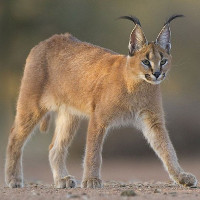 |
Caracal |
|
He is a wild animal |
Origin |
Southern and East Africa | |
Translation |
Francis Vandersteen |
| The possession of this animal is not authorized Royal Decree establishing the list of mammals not kept for production purposes that may be kept (M.B. 24.08.2009) |
| The Caracal, or desert lynx or Persian lynx, is a feline of the genus Caracal, widely distributed in Africa and Asia from the Middle East to the Indian subcontinent. In 2008, the caracal was classified as Least Concern on the IUCN Red List, due to its relatively common presence, particularly in southern and eastern Africa. The caracal is nevertheless considered threatened in North Africa and rare in Central Asia and India. The Caracal is a medium-sized mammal of the felidae family, with long legs and a relatively short tail that accounts for 30% of the animal's body length. It is distinguished by the presence of a cluster of long black hairs at the tip of the ears, almost exceeding their length, a characteristic it shares with the Lynx and the Marsh Cat. The hair is short, uniformly tawny-gray to reddish on the back, sides and tail. The chin, throat, chest, belly and inside of the legs are whitish and may be spotted with reddish or pale fawn spots. The muscular hindquarters are higher than the front. The Caracal's legs are fairly wide, with five toes on the front legs (the first of which does not touch the ground) and four on the hind legs, equipped with 3 cm-long retractable claws. The Caracal has numerous stiff hairs emerging from between its pads, providing good support on soft ground. Like all felines, the caracal is a territorial animal and does not accept other felines on its territory, which it marks by urinating on rocks and shrubs to leave olfactory marks. The caracal is solitary, but can be found in pairs during the breeding season, and females are accompanied by their young until they are 10 months old. The males' territory overlaps that of several females. The caracal is a nocturnal animal. It is active during the day, but avoids the hottest hours of the day, when it probably retreats into caves, crevices or cavities dug by other animals. This feline's body is looser than that of Nordic lynxes, making it an excellent runner. It is also an excellent climber. Its characteristic ears may serve as a means of communication. The caracal is mainly a nocturnal predator, but also hunts during the day, at dawn and dusk, when temperatures are not too high. It spots its prey by sight, but also uses the excellent hearing provided by its long, pointed ears adorned with black brushes. Its solid tawny yellow coat blends perfectly with the general color of the savannah and arid environments in which it lives, enabling it to camouflage well. Like a cat, it crawls silently, its body flattened against the ground, approaching its prey before pouncing on it. The caracal is considered one of the fastest felines over short distances. The caracal is also an excellent climber and jumper, capable of leaping 3 meters to capture birds in flight. It hunts mainly damselflies, rodents such as hares and smaller ones, monkeys and small baboons, small antelopes (ourebis, dorcas or Gazella dorcas), springboks and birds. It kills larger prey such as antelopes by biting the jugular vein. It can include fish, reptiles and beetles in its diet. More surprisingly, it can attack other carnivores such as sea lions, felines, foxes and mustelids. Like most felines, the caracal can ingest grass, but will also eat grapes. In southern Africa, in areas where extensive livestock farming is practiced, a caracal takes an average of around 5 domestic sheep per year from an area of 100 km2. It can also prey on domestic poultry. The daily meat ration required by a caracal is estimated at 800 g. |






 English (United Kingdom)
English (United Kingdom)